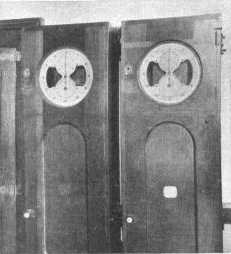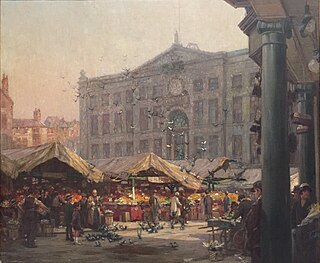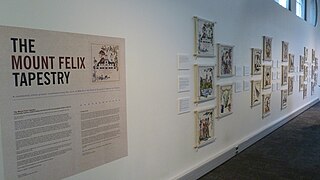
The Royal Observatory, Greenwich is an observatory situated on a hill in Greenwich Park in south east London, overlooking the River Thames to the north. It played a major role in the history of astronomy and navigation, and because the Prime Meridian passed through it, it gave its name to Greenwich Mean Time, the precursor to today's Coordinated Universal Time (UTC). The ROG has the IAU observatory code of 000, the first in the list. ROG, the National Maritime Museum, the Queen's House and the clipper ship Cutty Sark are collectively designated Royal Museums Greenwich.

A time signal is a visible, audible, mechanical, or electronic signal used as a reference to determine the time of day.

Standard time is the synchronization of clocks within a geographical region to a single time standard, rather than a local mean time standard. Generally, standard time agrees with the local mean time at some meridian that passes through the region, often near the centre of the region. Historically, standard time was established during the 19th century to aid weather forecasting and train travel. Applied globally in the 20th century, the geographical regions became time zones. The standard time in each time zone has come to be defined as an offset from Universal Time. A further offset is applied for part of the year in regions with daylight saving time.

Lyttelton is a port town on the north shore of Lyttelton Harbour / Whakaraupō, at the northwestern end of Banks Peninsula and close to Christchurch, on the eastern coast of the South Island of New Zealand.

William Henry Clayton was a Tasmanian-born colonial architect who practised initially in Tasmania and then in New Zealand. He was New Zealand's first Colonial Architect, serving in the position from 1869 up until his death. In this role, he and his office were responsible for the design of numerous government buildings.

The Deal Timeball is a Victorian maritime Greenwich Mean Time signal located on the roof of a waterfront four-storey tower in the coastal town of Deal, in Kent, England. It was established in 1855 by the Astronomer Royal George Biddell Airy in collaboration with Charles V. Walker, superintendent of telegraphs for the South Eastern Railway Company. It was built by the Lambeth firm of engineers Maudslay and Field. The time ball, which, like the Greenwich time ball, fell at 1 pm precisely, and was triggered by an electric signal directly from the Royal Observatory.

The Sydney Observatory is a heritage-listed meteorological station, astronomical observatory, function venue, science museum, and education facility located on Observatory Hill at Upper Fort Street, in the inner city Sydney suburb of Millers Point in the City of Sydney local government area of New South Wales, Australia. It was designed by William Weaver (plans) and Alexander Dawson (supervision) and built from 1857 to 1859 by Charles Bingemann & Ebenezer Dewar. It is also known as The Sydney Observatory; Observatory; Fort Phillip; Windmill Hill; and Flagstaff Hill. It was added to the New South Wales State Heritage Register on 22 December 2000.

The Williamstown Lighthouse more commonly known as the Williamstown Timeball Tower, is situated at Point Gellibrand, in the Melbourne suburb of Williamstown.

The Shepherd Gate Clock is mounted on the wall outside the gate of the Royal Observatory, Greenwich building in Greenwich, Greater London. The clock, an early example of an electrically connected clock system, was a sympathetic clock mechanism controlled by electric pulses transmitted by a motor clock inside the main building. The network of 'sympathetic clocks' was constructed and installed by Charles Shepherd in 1852. The clock by the gate was probably the first to display Greenwich Mean Time to the public, and is unusual in using the 24-hour analog dial. Also, it originally showed astronomical time which started at 12 noon, not midnight.
Robert Wauchope (1788–1862) was a British admiral in the Royal Navy, and the inventor of the time ball.

Upper Hutt railway station is a suburban railway station serving central Upper Hutt, New Zealand. The station is on the Wairarapa Line, 32.4 km (20.1 mi) north of Wellington, and is served by Transdev Wellington on behalf of the Greater Wellington Regional Council. The station is the northern terminus for the electrified Hutt Valley Line to and from Wellington. The diesel-hauled Wairarapa Connection stops at Upper Hutt on its route between Wellington and Masterton.

The Clock Tower is a free-standing clock tower in the centre of Brighton, part of the English city of Brighton and Hove. Built in 1888 in commemoration of the Golden Jubilee of Queen Victoria, the distinctive structure included innovative structural features and became a landmark in the popular and fashionable seaside resort. The city's residents "retain a nostalgic affection" for it, even though opinion is sharply divided as to the tower's architectural merit. English Heritage has listed the clock tower at Grade II for its architectural and historical importance.

The Lyttelton Timeball Station is a heritage-registered time ball station and prominent local landmark in Lyttelton, New Zealand. The original station was significantly damaged by a series of earthquakes and aftershocks in 2010 and 2011, and finally collapsed on 13 June 2011 after a magnitude 6.4 aftershock. The tower was subsequently reconstructed, reopening in November 2018.

The Chief Post Office or Christchurch Central Post Office, originally known as the Government Buildings, is located in Cathedral Square, Christchurch, New Zealand. The building was initially a post office with Immigration, Customs and Public Works departments. The Government Buildings were later replaced by the new Government Buildings opened in 1913, and the Chief Post Office remained on-site. In 1881, New Zealand’s first telephone exchange was installed in the building. Post services were offered from the building until 2000 when it was re-purposed to house a Christchurch tourist information centre and a restaurant, café and offices. Following the 2011 Christchurch earthquake the building closed. In the early 2020s repairs and strengthening took place. The building is planned to reopen in 2023 in stages, and will eventually include a restaurant, shops, and a visitor information centre, under the name "The Grand". The structure is registered with Heritage New Zealand as a Category I heritage building.
UNESCO Asia Pacific Heritage Awards are given with as the strategic purpose of UNESCO with in the region Asia Pacific. The objective is to motivate the protection of Cultural Heritage sites, which are initiated by any individual organization under private sector or institutional organization.

Nottingham Exchange was built in the Market Place in Nottingham between 1724 and 1726 as the main offices of the Nottingham Corporation.

The No. 2 New Zealand General Hospital was a World War I military hospital in Walton-on-Thames, England. The hospital opened in 1915 by requisitioning the essentially 15th century Mount Felix estate, a grand house with gardens, and closed in 1920.

Stephen James Carkeek was a New Zealand civil servant, the colony's first Inspector of Customs, and the builder of the oldest-surviving observatory in the country.
The Port Chalmers time ball is a Victorian maritime Greenwich Mean Time signal located on Aurora Terrace on top of Observation Point in the port of Port Chalmers, New Zealand. It was established in 1867 by the Otago Provincial Council. The time ball fell precisely at 1 p.m. daily. Originally triggered by a grandfather clock, from 1882 onwards a telegraph signal from Wellington took over this function. It was removed in 1970, but a replacement was restored to service in 2020.
































